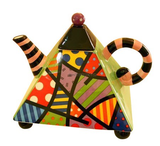Different brewing vessels
In this weeks Tea Academy addition we look at the different types of brewing vessels which can be used to make tea. There are so many different types but we have narrowed it down to our favorite.
 Let's begin our journey looking at glass tea ware which provides true visual entertainment as the tea leaves unfurl before your eyes but also serves as a practical reminder to stop the infusion when its at your desired strength. Here at BRUU we offer a beautiful handmade glass mug with built-in infuser called the Feng Infusion Mug but you can also find retailers stocking glass tea pots with candle powered heaters underneath.
Let's begin our journey looking at glass tea ware which provides true visual entertainment as the tea leaves unfurl before your eyes but also serves as a practical reminder to stop the infusion when its at your desired strength. Here at BRUU we offer a beautiful handmade glass mug with built-in infuser called the Feng Infusion Mug but you can also find retailers stocking glass tea pots with candle powered heaters underneath.
 If you prefer traditional style then it doesn’t get better than traditional Chinese porcelain. The infamous blue and white "fine china" was first developed during the Yuan Dynasty (1279-1368) and perfected during the Ming Dynasty (1368-1644). Aside from being elegant, porcelain is fantastic as it does not absorb any odours for future brews. Porcelain was once considered the rich man’s tea ware but these days there are many different designs and styles available which cover a wide range of prices from budget to luxurious. BRUU offers a The Yukita; a beautiful fine porcelain tea set with a teapot, four cups and a bamboo tray. This tea set allows you to recreate the eastern ritual of drinking tea alongside loved ones and also makes a beautiful ornamental show piece.
If you prefer traditional style then it doesn’t get better than traditional Chinese porcelain. The infamous blue and white "fine china" was first developed during the Yuan Dynasty (1279-1368) and perfected during the Ming Dynasty (1368-1644). Aside from being elegant, porcelain is fantastic as it does not absorb any odours for future brews. Porcelain was once considered the rich man’s tea ware but these days there are many different designs and styles available which cover a wide range of prices from budget to luxurious. BRUU offers a The Yukita; a beautiful fine porcelain tea set with a teapot, four cups and a bamboo tray. This tea set allows you to recreate the eastern ritual of drinking tea alongside loved ones and also makes a beautiful ornamental show piece.


Surprisingly the biggest tea drinkers are not found in the East but actually in Turkey. Turkish tea is typically prepared using two stacked kettles called "çaydanlık" specially designed for tea preparation. Water is brought to a boil in the larger lower kettle and then some of the water is used to fill the smaller kettle on top and infuse several spoons of loose tea leaves, producing a very strong tea. When served, the remaining water is used to dilute the tea on an individual basis, giving each consumer the choice between a strong deep brownish red or light weak. Tea is then traditionally drunk from small glasses.
 If you’re looking for the novelty factor then the choice is endless. They may not be the most practical choice or make the best brew but they make a great ornament on any kitchen shelf. Tea had reached Britain in the early-18th Century. Even from this early period the Staffordshire potteries produced teapots in the shape of houses, camels, squirrels and monkeys. Wedgwood and Whieldon produced one of the most famous range of teapots of the mid-18th Century which were shaped as garden vegetables and fruit. But if you’re looking to purchase one of these then you may need a small bank loan as the earliest vegetable shaped teapots are valued at £2,500-£3,000 (pictured).
If you’re looking for the novelty factor then the choice is endless. They may not be the most practical choice or make the best brew but they make a great ornament on any kitchen shelf. Tea had reached Britain in the early-18th Century. Even from this early period the Staffordshire potteries produced teapots in the shape of houses, camels, squirrels and monkeys. Wedgwood and Whieldon produced one of the most famous range of teapots of the mid-18th Century which were shaped as garden vegetables and fruit. But if you’re looking to purchase one of these then you may need a small bank loan as the earliest vegetable shaped teapots are valued at £2,500-£3,000 (pictured).
In Britain there is many collectors with impressive tea pot collections but they don’t come close to Tang Yu of China who holds the world record with his collection of 30,000 different teapots dated from the Song Dynasty to modern time.






